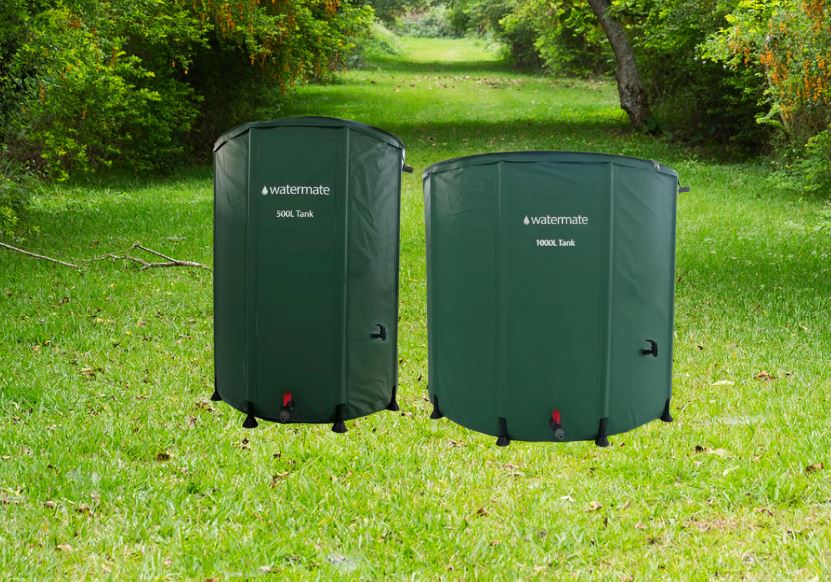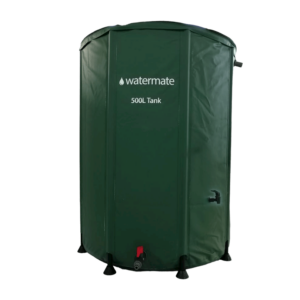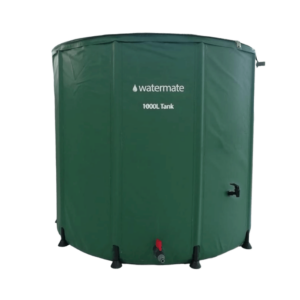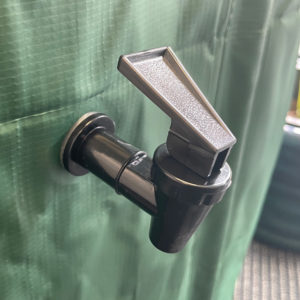Table of Contents
What are home water tanks?
Home water tanks, also known as water storage tanks are large containers used to store water in residential properties. They come in various sizes, materials, and designs, and are typically located outside the home.
The purpose of a home water tank is often to provide a backup water supply in case of emergencies such as water outages, natural disasters, or disruptions in the municipal water supply. Additionally, some homeowners use water tanks to collect rainwater for irrigation or other non-potable uses.
There are several types of home water tanks available, including:
- Plastic Tanks: These are the most common type of water storage tank for residential use. They are lightweight, affordable, and durable, and come in various shapes and sizes.
- Concrete Tanks: These tanks are heavy and require professional installation. They are very durable and long-lasting but can be expensive.
- Fiberglass Tanks: These tanks are lightweight and durable, and can be easily transported and installed. They are resistant to corrosion and can withstand extreme temperatures.
- Steel Tanks: These tanks are strong and durable, but can be prone to rust and corrosion if not properly maintained.
Home water tanks can also be classified by their installation method, which includes above-ground and below-ground tanks. Above-ground tanks are easier to install and maintain, but they can take up valuable outdoor space and can be unsightly. Below-ground tanks are hidden from view and can be more space-efficient, but they require excavation and professional installation.
Maintaining a home water tank is essential to ensure the quality and safety of the stored water. It is recommended to clean the tank periodically to remove sediment, algae, and other contaminants that can accumulate over time. Additionally, homeowners should regularly check the tank for leaks, damage, and signs of wear and tear.
Importance of having a water tank in your home
Having a water tank in your home can be an important investment for several reasons. Here are some of the key reasons why you might want to consider installing a water tank:
- Emergency Preparedness: In the event of an emergency or natural disaster, having a water tank can provide a backup supply of water that can be used for drinking, cooking, cleaning, and other essential needs. This can be particularly important in areas that are prone to drought, power outages, or other disruptions to the municipal water supply.
- Cost Savings: Depending on where you live, the cost of water can be quite high. By installing a water tank, you can collect rainwater and use it for non-potable purposes such as watering your garden, washing your car, or flushing your toilet. This can help reduce your water bill and save you money over time.
- Environmental Sustainability: Collecting rainwater in a water tank is a sustainable practice that can help reduce your household’s environmental impact. By using rainwater for non-potable purposes, you can reduce the amount of freshwater that you consume, which can help conserve this valuable resource.
- Increased Water Pressure: If you live in an area with low water pressure, a water tank can help increase the pressure of your household water supply. By storing water in a tank and using a pump to distribute it, you can enjoy stronger and more consistent water pressure throughout your home.
- Improved Water Quality: Municipal water supplies can sometimes be contaminated with chemicals, minerals, or other substances that can affect the taste and quality of the water. By collecting rainwater in a water tank, you can enjoy a cleaner and more natural source of water that is free from these contaminants.
Considerations When Buying a Water Tank
When buying a water tank, there are several considerations you need to take into account to ensure you choose the right type, size, and material for your needs. Here are some factors to consider:
- Purpose: Consider why you need a water tank. Is it for domestic use, irrigation, firefighting, or industrial use? Different applications will require different types of tanks.
- Material: Water tanks can be made from a range of materials, including plastic, steel, concrete, and fiberglass. Each material has its own advantages and disadvantages, so consider which material is best suited for your needs and budget.
- Size: Choose a tank that is the right size for your needs. Consider your household’s average daily water usage, the amount of rainfall in your area, and any future changes, such as additions to your home or increased water usage.
- Installation: Consider the location and installation requirements for your water tank. Make sure the tank is installed on a stable and level surface, and ensure there is enough space for the tank and any necessary equipment.
- Maintenance: Consider the maintenance requirements for your water tank. Some tanks require regular cleaning, inspection, and repairs, while others are more low-maintenance.
- Cost: Water tanks come in a range of prices, so consider your budget when choosing a tank. Keep in mind that while a cheaper tank may save you money upfront, it may have higher long-term maintenance costs.
- Warranty and Support: Look for a tank that comes with a warranty and good customer support. This can help you avoid costly repairs and ensure your tank lasts as long as possible.
By considering these factors when buying a water tank, you can choose a tank that is well-suited for your needs and provides reliable and sustainable water storage for years to come.
Water Tanks Sizes
Water tanks are available in a wide range of sizes to meet the diverse water storage needs of homes, businesses, and industries. Choosing the right size water tank is crucial to ensure you have sufficient water supply for your needs without wasting space or money.
Here are some of the most common sizes available for water tanks:
- Small Tanks: Small water tanks typically have a capacity of 100 to 500 litres. They are perfect for small households or as additional storage for larger properties. Small tanks are also ideal for use in compact spaces such as balconies, rooftops, and small gardens.
- Medium Tanks: Medium-sized water tanks have a capacity of 500 to 2,500 litres. They are suitable for larger households, small businesses, and agricultural purposes such as irrigation. Medium tanks are also commonly used in emergency preparedness kits for disaster relief.
- Large Tanks: Large water tanks range from 2,500 to 50,000 litres in capacity. They are suitable for large households, commercial or industrial applications, farms, and firefighting. Large tanks can also be used for rainwater harvesting to irrigate crops or supply water for livestock.
- Custom Tanks: Custom water tanks are designed to meet specific requirements, including non-standard sizes, shapes, and capacities. Custom tanks are suitable for businesses and industries that require unique water storage solutions.
When selecting the size of your water tank, consider factors such as the amount of water you need to store, available space for the tank, and your budget. Choose a tank size that meets your water storage needs and fits your available space while keeping in mind the maintenance and installation requirements.
More About Plastic Water Tanks
Plastic water tanks are an essential household item that is widely used for storing and preserving water. These tanks are made from high-quality plastic materials that are durable, easy to maintain, and safe for storing water. They come in various sizes such as 500L and 1000L and designs to cater to different household needs.
One of the significant advantages of using plastic water tanks is their affordability. Compared to other types of water storage tanks, plastic water tanks are relatively cheaper and more affordable. They are also lightweight, making them easy to transport and install. Plastic water tanks are also easy to clean and maintain, and they do not rust or corrode like metal tanks.
Plastic water tanks are commonly used in homes for storing and preserving rainwater, which can be used for various household purposes such as gardening, cleaning, and even drinking. They are also ideal for areas where there is a scarcity of water or frequent interruptions in the water supply.
Another benefit of plastic water tanks is that they are available in various shapes and sizes, making them suitable for any type of home or space. They can be installed underground or above the ground, depending on the homeowner’s preference and space availability.
Collapsible Tanks
Collapsible tanks, also known as pillow tanks or bladder tanks, are flexible containers made from a range of materials including PVC, TPU, and other synthetic fabrics. These tanks are designed to store liquids and can be easily transported and deployed in various environments.
Here are some of the benefits of collapsible tanks:
- Portability: Collapsible tanks are lightweight and can be easily transported to remote locations or areas with limited access. They are also compact when empty, making them easy to store and transport.
- Easy to Install: Collapsible tanks are quick and easy to set up, with minimal equipment or tools required. They can be assembled in a matter of hours, allowing for rapid deployment in emergency situations.
- Customizable: Collapsible tanks come in a variety of sizes and shapes, allowing for customization to meet specific requirements.
- Cost-Effective: Collapsible tanks are typically less expensive than traditional tanks made from steel or concrete. This makes them a cost-effective solution for temporary storage needs.
- Low Maintenance: Collapsible tanks require minimal maintenance, with no need for painting, coating, or rust prevention. They are also easy to clean and can be reused multiple times.
Maintenance of Home Water Tanks
Cleaning Home Water Tanks
Proper cleaning of your water tank is essential to ensure the quality of the water you use for drinking, cooking, and other household purposes such as in the garden. Over time, sediment, debris, and bacteria can build up in the tank, leading to foul odours and potential health risks.
Here are some tips for cleaning your water tank:
- Turn off the water supply to the tank and drain the tank completely.
- Remove any debris, sediment, or other material from the tank.
- Mix a cleaning solution of water and bleach in a ratio of 1:10 (one part bleach to ten parts water).
- Use a brush or scrubber to clean the inside of the tank thoroughly, making sure to remove any buildup or residue.
- Rinse the tank with clean water several times, making sure all traces of the cleaning solution are removed.
- Refill the tank with clean water and turn on the water supply.
- Test the water quality to ensure it is safe for use.
It is recommended to clean your water tank at least once a year, and more frequently if you notice any signs of contamination or buildup. In addition to regular cleaning, it is also important to inspect your water tank for any signs of damage or wear and tear, and to address any issues promptly to avoid water leaks or contamination.
Repair and Maintenance
Regular repair and maintenance of your water tank is essential to ensure its longevity and proper functioning. Neglecting maintenance can lead to leaks, contamination, and other issues that can compromise the quality of your water supply and pose health risks.
Here are some tips for maintaining and repairing your water tank:
- Inspect your water tank regularly for signs of damage or wear and tear, such as cracks, leaks, or corrosion.
- Keep the area around the tank clear of debris and vegetation to prevent damage or obstruction.
- Check the fittings, valves, and hoses connected to the tank for leaks, cracks, or other damage.
- Ensure the lid or cover of the tank is properly sealed and secure to prevent contamination from outside sources.
- Flush the tank regularly to remove sediment and debris that can accumulate over time.
- Replace damaged or worn parts promptly, including gaskets, valves, and hoses.
- Hire a professional plumber or technician to inspect and maintain your water tank periodically, especially for larger or more complex systems.
- Consider installing a water filtration or treatment system to improve water quality and reduce the need for maintenance.
By following these tips and practicing regular maintenance and repair, you can ensure the longevity and efficiency of your water tank and protect the quality of your water supply. It is also important to consult with a professional plumber or technician for more complex repairs or installations, to ensure proper and safe handling of your water system.
-
Rated 4.78 out of 5
$149.90Original price was: $149.90.$119.90Current price is: $119.90. Add to cart -
Rated 4.78 out of 5
$249.90Original price was: $249.90.$199.90Current price is: $199.90. Select options





